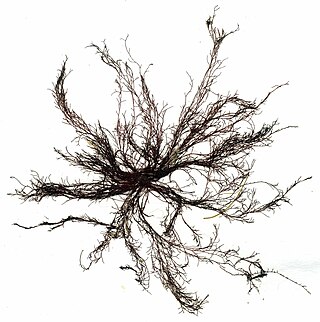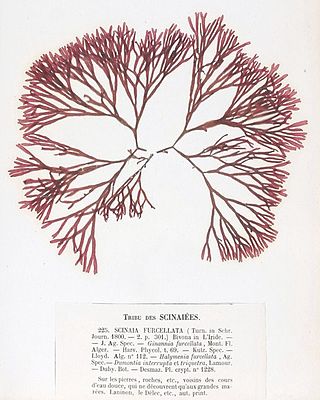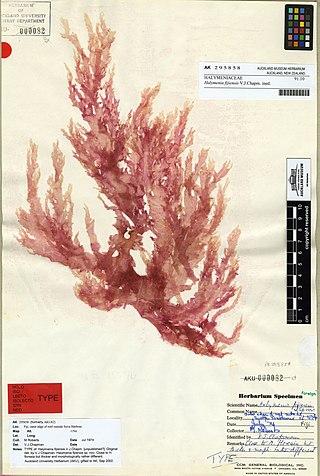Related Research Articles

Palmaria palmata, also called dulse, dillisk or dilsk, red dulse, sea lettuce flakes, or creathnach, is a red alga (Rhodophyta) previously referred to as Rhodymenia palmata. It grows on the northern coasts of the Atlantic and Pacific Oceans. It is a well-known snack food. In Iceland, where it is known as söl, it has been an important source of dietary fiber throughout the centuries.

Atractophora hypnoides is a rare red alga (Rhodophyta) found in the British Isles, France and some Atlantic Islands and is the only species of the genus found in the British Isles. It is attached to the rock or other algae by a small basal disc and is much branched with downgrowing filaments which enclose the main branch or axis forming a cortex. Short filaments of limited growth radiate in whorls from the axis and frequently convert into hairs. The spreading filaments grow irregularly in a diffuse manner. Microscope examination is required for identification.

AlgaeBase is a global species database of information on all groups of algae, both marine and freshwater, as well as sea-grass.
Schmitzia hiscockiana is a small, rare, red seaweed or marine alga of the phylum Rhodophyta or red algae. It was discovered and named in 1985.
Ascoseira is a monotypic genus of seaweed in the brown algae. The single and type species, Ascoseira mirabilis Skottsberg, is a large parenchymatous macroalgae, and is endemic to the Antarctic Ocean. Ascoseira is assigned to its own order. The alga grows in subtidal waters at depths of from 3 to 15 meters.

Polysiphonia is a genus of filamentous red algae with about 19 species on the coasts of the British Isles and about 200 species worldwide, including Crete in Greece, Antarctica and Greenland. Its members are known by a number of common names. It is in the order Ceramiales and family Rhodomelaceae.
Rhipiliopsis is a genus of green algae in the family Rhipiliaceae. Johnson-sea-linkia is a synonym.
Bangia is an extant genus of division Rhodophyta that grows in marine or freshwater habitats. Bangia has small thalli with rapid growth and high reproductive output, and exhibits behavior characteristic of r-selected species. The plants are attached by down-growing rhizoids, usually in dense purple-black to rust-colored clumps. The chloroplasts of Bangia, like others in the division Rhodophyta, contain chlorophyll a and sometimes chlorophyll d, as well as accessory pigments such as phycobilin pigments and xanthophylls. Depending on the relative proportions of these pigments and the light conditions, the overall color of the plant can range from green to red to purple to grey; however, the red pigment, phycoerythrin, is usually dominant.

Claudea is a marine red alga genus.
Sirodotia Kylin (1912) is a genus of freshwater red alga which was described by Kylin in 1912, and placed in the Batrachospermaceae family.

Polysiphonia stricta is a small red marine alga in the Division Rhodophyta.

Batrachospermaceae is a family of fresh water red algae (Rhodophyta). Genera within the Batrachospermaceae generally have a "Lemanea-type" life history with carpospores germinating to produce chantransia. Sporophyte phase with meiosis occurs in an apical cell to produce the gametophyte stage. Pit connections have two pit plug cap layers with the other layer enlarged. This family of freshwater red algae is uniaxial, meaning each filament with a single apical cell. The genera included within Batrachospermaceae are listed in the table below.

Mastocarpus papillatus, sometimes called Turkish washcloth, black tar spot, or grapestone is a species of red algae in the family Phyllophoraceae. It is sometimes confused with the distantly related Turkish towel which is of a similar texture but larger. The specific epithet papillatus is due to the nipple-like projections on the female gametophyte which can give the texture of a terrycloth washcloth found at a Turkish bath.
Desmarestia ligulata is a species of brown algae found worldwide. Its common names include color changer, Desmarest's flattened weed, and sea sorrel, though the last name can also refer to other species of Desmarestia.

Odonthalia dentata is a medium-sized marine red alga.

Timothy John Entwisle, is an Australian botanist, much of whose research work is in phycology (algae). See for example the articles. He was awarded a Ph.D. from La Trobe University in 1986 for work on the taxonomy of Vaucheria.
Zanardinia is a monotypic genus of seaweed in the brown algae. The only species, Zanardinia typus, commonly known as penny weed, is native to the northeastern Atlantic Ocean and the Mediterranean Sea.

Rissoella verruculosa is a species of red algae, the only accepted species in the genus Risoella and the family Rissoellaceae. This species is endemic to the Mediterranean Sea.

Scinaiaceae is a family of red algae (Rhodophyta) in the order Nemaliales.

Halymeniales is an order of red algae belonging to the class Florideophyceae and the subclass Rhodymeniophycidae.
References
- 1 2 M.D. Guiry. "Entwisleia F.J.Scott, G.W.Saunders & Kraft, 2013 :: Algaebase". www.algaebase.org. Guiry, M.D. & Guiry, G.M. 2019. AlgaeBase. World-wide electronic publication, National University of Ireland, Galway. Retrieved 24 October 2019.
- 1 2 3 4 5 6 Scott, Fiona J.; Saunders, Gary W.; Kraft, Gerald T. (2013). "Entwisleia bella, gen. et sp. nov., a novel marine 'batrachospermaceous' red alga from southeastern Tasmania representing a new family and order in the Nemaliophycidae". European Journal of Phycology. 48 (4): 398–410. doi:10.1080/09670262.2013.849359. ISSN 0967-0262. S2CID 85309943. pdf
- ↑ Smith, Bridie (1 September 2013). "Sea! Alga discovery a feather in expert's cap". The Age. Retrieved 29 October 2019.
- ↑ Entwisle, T. (September 2013). "Talking Plants: New Seaweed may be Hobart's Wollemi Pine". Talking Plants. Retrieved 29 October 2019.
- ↑ Burkhardt, Lotte (2022). Eine Enzyklopädie zu eponymischen Pflanzennamen [Encyclopedia of eponymic plant names](pdf) (in German). Berlin: Botanic Garden and Botanical Museum, Freie Universität Berlin. doi:10.3372/epolist2022. ISBN 978-3-946292-41-8 . Retrieved 27 January 2022.